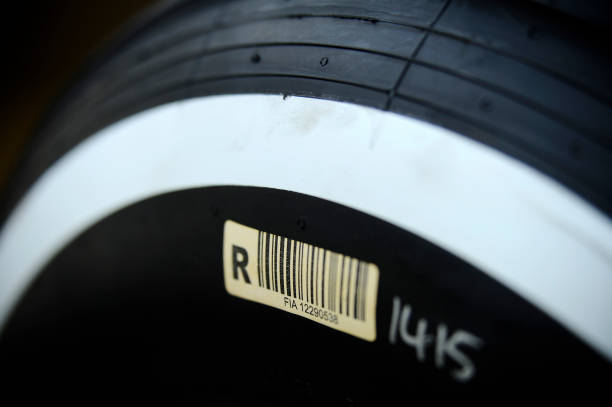To read tire codes, locate the alphanumeric sequence on the tire sidewall. This sequence provides vital information about the tire’s specifications.
Tire codes can seem confusing at first glance. These alphanumeric sequences are crucial for understanding your tire’s size, type, and performance capabilities. Typically found on the tire’s sidewall, these codes include details such as width, aspect ratio, construction type, and diameter.
Knowing how to read these codes ensures you select the right tire for your vehicle, enhancing safety and performance. It also helps in making informed decisions during tire purchases and maintenance. Understanding tire codes is essential for every vehicle owner, simplifying the process of tire selection and ensuring optimal driving conditions.

Introduction To Tire Codes
Tire codes provide essential information about your tires. They help identify the type, size, and performance of the tire. Understanding these codes ensures you get the right tire for your vehicle. Proper knowledge of tire codes can improve safety and efficiency.
Importance Of Tire Codes
Tire codes are crucial for several reasons:
- Safety: Correct tire selection ensures safe driving.
- Performance: Proper tires improve vehicle performance.
- Fuel Efficiency: Right tires help in saving fuel.
- Longevity: Appropriate tires last longer.
Where To Find Tire Codes
You can find tire codes on the tire sidewall. The sidewall contains a series of numbers and letters. These codes are usually embossed or printed. Here is an example:
| Code | Meaning |
|---|---|
| P215/65R15 95H |
|
Breaking Down The Tire Code
Understanding tire codes can seem complex, but it’s essential for vehicle safety. Tire codes provide crucial information about tire type, size, and performance. This guide will help you decode the tire code on your vehicle.
Understanding The Letters
The letters in a tire code reveal important details. The first letter usually indicates the type of vehicle the tire fits. For example:
- P stands for Passenger vehicle
- LT stands for Light Truck
- T stands for Temporary (spare tires)
Another common letter is R, which stands for Radial construction.
Decoding The Numbers
The numbers in the tire code provide detailed measurements. Here’s a breakdown:
| Part of Code | Meaning |
|---|---|
| 205 | Tire width in millimeters |
| 55 | Aspect ratio (height to width) |
| 16 | Diameter of the wheel in inches |
For example, a tire code of P205/55R16 means:
- P: Passenger vehicle
- 205: Width of 205 mm
- 55: Aspect ratio of 55%
- R: Radial construction
- 16: Fits 16-inch wheel
Understanding these codes ensures you choose the right tires for your vehicle.
Tire Type And Width
Understanding tire codes helps ensure safe and efficient driving. Tires have different types and widths. This section will focus on identifying tire type and measuring tire width.
Identifying Tire Type
The first letter in a tire code indicates the tire type. Common types include:
- P – Passenger vehicle tire
- LT – Light truck tire
- T – Temporary spare tire
For example, in the tire code P215/65R15, the P stands for passenger vehicle tire. Knowing the tire type helps you choose the right tire for your vehicle.
Measuring Tire Width
The width of the tire is measured in millimeters. This is shown as a three-digit number after the tire type letter. In the tire code P215/65R15, the 215 indicates the tire width.
Tire width affects the vehicle’s handling and performance. Wider tires offer better grip but may reduce fuel efficiency. Narrower tires can improve fuel economy but might not handle as well.
| Tire Code | Type | Width (mm) |
|---|---|---|
| P215/65R15 | Passenger | 215 |
| LT245/75R16 | Light Truck | 245 |
Use this information to choose the best tire for your vehicle. Proper tire selection ensures safety and efficiency on the road.

Aspect Ratio And Construction
Understanding tire codes is crucial for maintaining your vehicle. Two key elements to know are the aspect ratio and the construction type. These determine how your tires will perform.
Reading Aspect Ratio
The aspect ratio is found after the tire width in the code. It looks like this: 225/50R17. The number after the slash is the aspect ratio. In our example, it’s 50.
The aspect ratio is the height of the tire’s sidewall as a percentage of the tire’s width. For a tire with a width of 225mm and an aspect ratio of 50, the sidewall height is 112.5mm (225mm 50%).
Here’s a quick reference table:
| Aspect Ratio | Sidewall Height (Percentage of Width) |
|---|---|
| 40 | 40% |
| 50 | 50% |
| 60 | 60% |
Understanding Construction Type
The construction type is indicated by a letter after the aspect ratio. For example, in 225/50R17, the letter R stands for Radial.
There are two main types of tire construction:
- Radial (R): Most common type. Offers a smoother ride and better fuel efficiency.
- Bias-Ply (B): Less common. Generally used for specific applications like trailers.
Radial tires have layers of fabric with cords running at 90 degrees to the direction of travel. Bias-ply tires have crisscrossing layers, making them less flexible but more durable.
Understanding these codes helps you choose the right tires for your vehicle. It ensures better performance and safety.
Diameter And Load Index
Understanding tire codes is essential for vehicle maintenance. The diameter and load index are key components. They ensure your tires fit and perform as expected.
Determining Diameter
The tire diameter is crucial for fitting your vehicle. You can find it on the sidewall of the tire.
For example, in the code P215/65R15, the 15 stands for the diameter in inches. The diameter must match the wheel size for a proper fit.
A mismatch can lead to poor handling and unsafe driving conditions.
Interpreting Load Index
The load index indicates the maximum weight a tire can carry. This number is also found on the tire’s sidewall.
In the code P215/65R15 95H, the 95 is the load index. Each number correlates to a specific weight capacity.
| Load Index | Weight Capacity (lbs) |
|---|---|
| 90 | 1,323 |
| 91 | 1,356 |
| 92 | 1,389 |
| 93 | 1,433 |
| 94 | 1,477 |
| 95 | 1,521 |
Choose a tire with a load index that meets or exceeds your vehicle’s requirements. This ensures safety and optimal performance.
Speed Rating And Additional Markings
Understanding tire codes can save you from potential hazards. Two crucial parts of these codes are the speed rating and additional markings. These elements provide valuable information about your tire’s performance and safety capabilities. Let’s dive into these important components.
Decoding Speed Rating
The speed rating indicates the maximum speed a tire can handle. This rating is usually found after the load index on the tire sidewall. For example, in the code P215/65R15 95H, the letter H represents the speed rating.
| Speed Rating | Maximum Speed (mph) |
|---|---|
| Q | 99 |
| R | 106 |
| S | 112 |
| T | 118 |
| H | 130 |
| V | 149 |
| Z | 149+ |
Make sure your tire’s speed rating matches your vehicle’s requirements. Using a tire with a lower speed rating can be dangerous.
Identifying Additional Markings
Additional markings on tires give more information about their capabilities. These markings include symbols and codes denoting various features.
- M+S: Indicates the tire is suitable for Mud and Snow.
- Three-Peak Mountain Snowflake (3PMSF): Denotes severe snow service ratings.
- RF: Indicates a Run-Flat tire.
- XL: Stands for Extra Load capacity.
- DOT: The tire meets the Department of Transportation standards.
Always check these additional markings to ensure the tire meets your driving conditions.
Seasonal And Performance Indicators
Understanding how to read tire codes can increase your vehicle’s performance and safety. The codes on your tire’s sidewall reveal crucial information about their type, size, and capabilities. This section will focus on Seasonal and Performance Indicators, which are essential for selecting the right tires for your driving conditions.
Recognizing Seasonal Indicators
Seasonal indicators help you choose tires suitable for different weather conditions. They are marked with specific symbols and letters.
- All-Season Tires: These are marked with “M+S” (Mud and Snow). They perform well in mild winter conditions.
- Winter Tires: Look for the “Three-Peak Mountain Snowflake” symbol. These tires are designed for heavy snow and ice.
- Summer Tires: They usually lack specific symbols. Their tread design and rubber compound offer excellent grip in warm conditions.
Understanding Performance Codes
Performance codes indicate the tire’s speed rating and load capacity. These codes are usually found after the tire size on the sidewall.
| Speed Rating | Maximum Speed (mph) |
|---|---|
| S | 112 |
| T | 118 |
| H | 130 |
| V | 149 |
| Z | Above 149 |
Load Index is another critical factor. It tells how much weight the tire can carry safely.
- Load Index 75: Supports up to 853 lbs.
- Load Index 95: Supports up to 1,521 lbs.
- Load Index 105: Supports up to 2,039 lbs.
Understanding these codes ensures you select the right tire for your driving needs.

Tips For Maintaining Tires
Proper tire maintenance ensures safety and prolongs tire life. Follow these tips to keep your tires in top shape.
Regular Inspection Tips
Regular inspections help detect issues early. Here are some tips for thorough inspections:
- Check tire treads for wear and tear.
- Look for any cuts or punctures.
- Inspect sidewalls for cracks or bulges.
- Ensure there are no foreign objects in the treads.
Proper Inflation Guidelines
Maintaining the correct tire pressure is crucial. Follow these steps to ensure proper inflation:
- Check the recommended pressure in the owner’s manual.
- Use a reliable tire gauge to measure pressure.
- Inflate tires to the recommended pressure level.
- Check tire pressure monthly and before long trips.
Properly inflated tires improve fuel efficiency and safety.
| Inspection Frequency | Action Required |
|---|---|
| Monthly | Check tire pressure and treads |
| Before Long Trips | Inspect for cuts, punctures, and foreign objects |
Frequently Asked Questions
What Do The Numbers And Letters On A Tire Mean?
The numbers and letters on a tire indicate its size, type, and performance specifications. They include width, aspect ratio, construction type, and diameter. The load index and speed rating are also provided. This information helps you choose the right tire for your vehicle.
What Does The 4 Digit Number On A Tire Mean?
The 4-digit number on a tire indicates its manufacture date. The first two digits represent the week, and the last two signify the year. For example, “2419” means the tire was made in the 24th week of 2019.
What Are The Letters On The Tire Date Code?
The letters on the tire date code indicate the manufacturing plant. The four-digit number shows the week and year of production.
What Is The Digit Code On A Tire?
The digit code on a tire is known as the Tire Identification Number (TIN). It includes information about the tire’s manufacturer, size, and production date. This code helps in identifying and tracking the tire’s specifications and history.
Conclusion
Understanding tire codes is essential for safety and performance. These codes reveal critical information about tire size, type, and capabilities. Always refer to your vehicle’s manual for recommended tire specifications. Regularly check your tires to ensure they meet these standards.
This simple practice can significantly increase your driving experience and vehicle longevity.





















